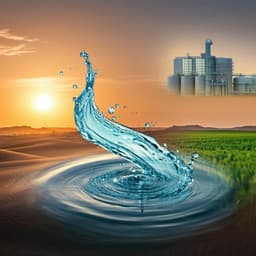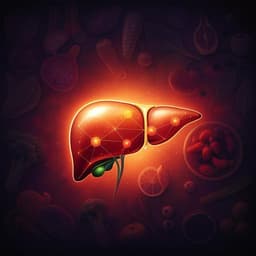
Environmental Studies and Forestry
Water quality footprint of agricultural emissions of nitrogen, phosphorus and glyphosate associated with German bioeconomy
A. C. Schomberg, S. Bringezu, et al.
This research reveals alarming insights into the pollution footprint of Germany's bioeconomy, showcasing unprecedented levels of nitrogen, phosphorus, and glyphosate emissions. With virtual water needed for dilution surpassing the volume of Lake Constance in 2020, the implications for global water use are profound. Conducted by Anna C. Schomberg, Stefan Bringezu, and Arthur W. H. Beusen, this study emphasizes the critical need for monitoring agricultural practices worldwide.
~3 min • Beginner • English
Introduction
The bioeconomy is promoted as a strategy to build a sustainable, resource-efficient economy by using biological resources across sectors (agriculture, forestry, fisheries, food, pulp and paper, parts of chemical, biotechnological and energy industries). However, relying on renewables does not inherently ensure sustainability; performance must be gauged against planetary boundaries. Prior monitoring of the German bioeconomy using footprint indicators (climate, fossil energy, material, land, water) shows impacts such as land-use change, irrigation water use, and GHG emissions. This study adds an indicator addressing water pollution, which contributes to scarcity of clean freshwater because polluted water cannot satisfy higher-quality demands. The concept used is the virtual dilution volume (VDV), a qualitative water scarcity footprint expressing emissions as the volume of demineralised water required to dilute pollutants to natural background or target thresholds. Unlike many grey water footprint approaches, the method uses basin-wide natural water quality as reference and WHO drinking water thresholds, treating catchments as single units and diluting to background concentrations (or targets) rather than to local thresholds using pre-loaded water. The study applies this water quality footprint to agricultural nitrogen (N), phosphorus (P) and glyphosate (G) associated with German bioeconomy supply chains (imports and domestic production) in 1995 and 2020, aiming to quantify Germany’s global water quality footprint from agricultural inputs and identify hotspots.
Literature Review
The study builds on extensive work on grey water footprinting and water scarcity metrics. Early concepts used average dilution factors for wastewater to reach acceptable levels (e.g., Falkenmark and Lindh, 1974; Postel et al., 1996). Later, substance-specific dilution and the grey water footprint were formalised as pollutant load divided by threshold concentrations, sometimes adjusted by subtracting natural background (Hoekstra and colleagues, 2008–2011). Grey water footprints have been widely applied to agricultural N and P pollution at global and regional scales (e.g., Mekonnen & Hoekstra, 2015, 2018). A water scarcity footprint concept for LCA reframed quality and quantity within catchments as unified hydrological systems, advocating dilution to naturally prevailing background concentrations or WHO drinking water targets, and fair dilution with demineralised water across supply chains (Schomberg et al., 2021). Additional literature addresses nutrient and pesticide fate, leaching and runoff processes, soil P reservoirs and N-use efficiency, and models such as IMAGE-GNM for nutrient fluxes and USEtox for chemical fate and exposure. This work adapts these concepts and tools to create a country-level water quality footprint indicator for agricultural pollution in the German bioeconomy.
Methodology
Overall approach: The water quality footprint is quantified as the virtual dilution volume (VDV) needed to reduce agricultural emissions of nitrogen (N), phosphorus (P), and glyphosate (G) below substance-specific reference concentrations. Results are calculated at producer country level and then allocated to the German bioeconomy via multi-regional input-output (MRIO)-based shares for 1995 and 2020.
Steps: (1) Compute country-level VDVs for agriculture: emissions to water (sum of emissions to surface water and groundwater; for P, groundwater leaching is neglected) are divided by geogenic background concentration (for natural substances N, P) or target concentration (WHO drinking water threshold; used for G and when background is zero or exceeds the target). Demineralised water is assumed for dilution to ensure fair comparison. Local to regional conditions governing emission pathways are embodied by input models. (2) Determine the raw material input shares of the German bioeconomy using EXIOBASE MR-IOT for 1995 and 2020 (including domestic consumption and exports). Rest-of-world regions are downscaled to country level using FAOSTAT production volumes and agricultural areas, converting production-quantity shares to area-related shares aligned with emission data. (3) Express German-associated footprints in m3 per German inhabitant for 1995 and 2020 and classify country water stress via withdrawal-to-availability ratios (WTA) computed from AQUASTAT.
Pollutants and emission modelling: - Nitrogen (N): Total dissolved inorganic N emissions to surface water (runoff, soil loss) and groundwater (leaching) are derived from an N mass balance using IMAGE-GNM (0.5° grid). Denitrification during groundwater residence is accounted for by applying a factor (f_denit) derived from established methods (van Drecht et al.), multiplied with leaching. Country totals are aggregated via GIS zonal statistics. - Phosphorus (P): Emissions to surface water (runoff, soil loss) are taken from IMAGE-GNM (0.5° grid) for 1995 and 2020; P leaching to groundwater is neglected based on literature indicating dominance of surface runoff globally. - Glyphosate (G): Application rates are taken from PEST-CHEMGRIDS (2020). The mass fraction reaching freshwater (surface and groundwater) after sorption and (bio)degradation is obtained from USEtox, then multiplied by application to estimate emissions.
Reference concentrations: - Geogenic background concentrations for N and P are compiled at country level from literature; if missing, continent medians or a global median are used. - WHO drinking water targets are used as the reference for G and where backgrounds are zero or exceed targets. Surface and groundwater are treated as a single catchment unit.
Computation of VDV: VDV_dem,i [m3] = load_em,i [kg] / C_ref,i [kg m−3], where C_ref is the geogenic background (for N, P) or the WHO target (for G or when background exceeds target or is zero). The largest substance-specific VDV in a country is termed the critical volume and represents the water quality footprint for that country’s agriculture (it effectively dilutes the other substances with smaller VDVs).
Allocation to German bioeconomy: Country-level agricultural VDVs are multiplied by Germany’s share of agricultural production (area-adjusted) in that country derived from EXIOBASE (1995, 2020) and FAOSTAT downscaling. Agriculture covers eight EXIOBASE crop categories. The allocation relates the German bioeconomy’s share to total sectoral emissions, not to crop-specific import composition. Results are normalised per German inhabitant.
Water stress assessment and classification: Water stress is represented by WTA (total freshwater withdrawal divided by total renewable resources) per country using AQUASTAT data for 1995 and 2020. Stress classes: low (WTA < 0.2), middle (0.2 ≤ WTA < 0.4), high (WTA ≥ 0.4). Footprint magnitude per country per German inhabitant is classified as low (<4.6 m3), medium (4.6–460 m3), and high (>460 m3), referencing German direct domestic water withdrawal (GDW) of 46 m3 per person per year (2020).
Comparative analyses: - Comparison of virtual dilution volumes to actual irrigation withdrawals (AQUASTAT) for 2020. - Virtual dilution-to-availability ratio (VTA) comparing total agricultural VDV to natural water availability for 1995 and 2020. - Temporal comparison of critical dilution volume and FAOSTAT total agricultural yield (ratio 2020/1995) by country to assess efficiency trends.
Uncertainty and sensitivity: Key inputs (loads/applications, USEtox mass fraction, German share, background/target concentrations) are subject to uncertainty. Sensitivity shows VDV is proportional to loads, mass fraction, and share, and inversely and nonlinearly sensitive to background/target concentrations (high sensitivity to underestimations). Data uncertainties are acknowledged for IMAGE-GNM, EXIOBASE, PEST-CHEMGRIDS, and literature-derived background concentrations.
Key Findings
- Magnitude of German bioeconomy’s water quality footprint (2020): Approximately 4000 Gm3 of virtual dilution volume required to dilute agricultural N, P, and G pollution associated with the German bioeconomy, equivalent to about 90 times Lake Constance’s volume. Domestic German production accounts for 22% (about 20 Lake Constances). Compared to 1995, total VDV increased by about one third; the domestic share decreased by 16%.
- Country contributions and per-capita perspective: Germany itself has the largest per-capita footprint at about 14,000 m3 per German inhabitant (≈300× GDW of 46 m3 a−1). Brazil and China follow, with about half and one-third of Germany’s value, respectively. In 2020, Germany is associated with high water quality footprints (exceeding GDW) in 49 countries (up from 33 in 1995), spanning all continents.
- Hotspots of clean water scarcity: Countries combining high footprints and medium to high water stress include China, Spain, India (major hotspots), and also Iran, Turkey, Pakistan, among others. Severe hotspot classification includes Iran, Spain, Turkey, India, and China; followed by Tunisia, Egypt, Sudan, Lebanon, Uzbekistan, and Pakistan.
- Comparison with irrigation water: For 2020, in only six countries (Bahrain, Barbados, Cape Verde, Dominica, Brunei, Belize) do irrigation withdrawals exceed the corresponding virtual dilution volume. In roughly a quarter of countries, VDV is up to 100× irrigation withdrawals; for the majority, VDV exceeds irrigation by more than 100×, and for over half of those, by more than 1000× (notably Mexico, Mongolia, Malaysia, India, Mali).
- Substance contributions: Phosphorus is responsible for the critical (largest) dilution volume in almost all 198 countries and island states. Belarus is the only country where nitrogen is critical (1995 and 2020). Glyphosate is never the critical driver in 2020, reflecting smaller application quantities despite low target concentrations.
- Virtual dilution vs availability: In several countries, total agricultural VDV can exceed natural water availability (VTA > 1 for agriculture alone), particularly moving from concentration in Europe (1995) to broader regions incl. North Africa, the Middle East, India, and China (2020). Germany’s share of VDV relative to a country’s water availability is very small (median order ~10^−11; maximum ~10^−7).
- Temporal dynamics and trade structure: From 1995 to 2020, fertilizer and pesticide applications generally rose, increasing VDVs. Germany’s associated VDV in India increased sevenfold due to higher total VDV and a modest increase in Germany’s share. In Germany, both total VDV and domestic consumption share declined. The Netherlands’ German share of production fell from 35% (1995) to 10% (2020). Mexico’s share declined from 1% to 0.3%. Suppliers from Africa, Southeast Asia, and the Pacific gained importance in 2020.
- Yield versus dilution: Across countries, no clear global correlation exists between rising yields and dilution volumes. Many countries (especially in Africa and the Asian-Pacific regions) show strong increases in dilution volumes with only small yield gains, suggesting possible inefficiencies or disproportionate fertilizer/pesticide use. Some countries (including India, several in Europe, and Germany) show more efficient use where dilution rose less than yields.
Discussion
The study set out to quantify and locate hotspots of the German bioeconomy’s agricultural water quality footprint using a volumetric dilution perspective that enables comparison with quantitative water use and regional water stress. Results demonstrate that pollution-related virtual dilution volumes are very large compared to direct water uses and often far exceed irrigation withdrawals, indicating that water pollution can contribute more to clean water scarcity than direct abstraction. Embedding regional water stress via WTA helps identify current hotspots where high footprints coincide with medium to high stress (e.g., India, Spain, China, Iran, Pakistan). Temporal comparison (1995–2020) reveals growing global footprints, shifts in supply structures, and emerging regions where increased inputs have not produced commensurate yield gains, pointing to potential inefficiencies and environmental risks with German participation.
These findings support incorporating water quality footprints into national bioeconomy monitoring to track and manage pollution-driven scarcity alongside traditional water quantity indicators. They highlight the importance of prioritising interventions in current hotspots and monitoring potential future hotspots where rising stress could exacerbate impacts (e.g., USA, Southern Europe, Ukraine, Turkey, China, India, Australia). The approach also enables evaluating trends and potential decoupling of yields from pollution, informing efficiency improvements, policy design, and supply chain due diligence.
Conclusion
The paper introduces and applies a water quality footprint indicator based on virtual dilution volumes for agricultural emissions of nitrogen, phosphorus, and glyphosate linked to the German bioeconomy. Using a modified grey water footprint rooted in the natural state of water (geogenic backgrounds or WHO targets) and country-level allocations from EXIOBASE refined with FAOSTAT, the study quantifies large virtual dilution volumes relative to direct uses, identifies spatial hotspots of clean water scarcity, and reveals temporal increases between 1995 and 2020. Phosphorus generally dominates the critical dilution volume, and many countries exhibit rising pollution not matched by yield gains, especially in Africa and the Asian-Pacific regions. Despite uncertainties and coarse resolution, the indicator is suitable for national monitoring, highlighting where German supply chains contribute most to pollution-related scarcity and where mitigation could be most effective. Future work should refine databases and resolution (spatially and by product), extend the set of pesticides beyond glyphosate, improve emission factor accuracy, and develop benchmarks to evaluate efficiency trends over time.
Limitations
- Data uncertainty and model assumptions: IMAGE-GNM nutrient fluxes, PEST-CHEMGRIDS applications, USEtox mass fractions, EXIOBASE trade shares, and literature-based geogenic background concentrations all carry uncertainties, sometimes large (background values may be uncertain up to ~100%). VDV is highly sensitive to underestimation of background/target concentrations.
- Spatial resolution: Results are at country level, the best common aggregation across datasets (grid-based emissions, region/country-level backgrounds, MRIO regions, national water stress). This may mask subnational heterogeneity and hotspot dynamics; hydrological processes are catchment-based. Downscaling would require further assumptions and may increase uncertainty.
- Temporal coverage: Only two years (1995 and 2020) are analysed, limiting trend interpretation. Finer time steps could better reveal dynamics and drivers.
- Pollutant scope: Only one pesticide (glyphosate) is included; other pesticides may have higher leaching or lower target concentrations and could yield larger VDVs. Hence, current estimates may be conservative.
- Allocation and sectoral aggregation: German shares are applied to total agricultural sector emissions without crop-specific import composition; EXIOBASE’s coarse rest-of-world regions introduce uncertainty in spatial attribution. Crop-level and product-specific disaggregation is planned but not yet implemented.
- Conceptual constraints: VDVs are virtual (not actual consumptive use), intended to volumetrically express pollution. Comparisons with real water withdrawals (e.g., irrigation) highlight magnitude but should be interpreted cautiously.
- Validation: While IMAGE-GNM concentrations are validated in river basins, flux validation and the specific combinations of datasets used here were not independently validated within this study.
Related Publications
Explore these studies to deepen your understanding of the subject.







